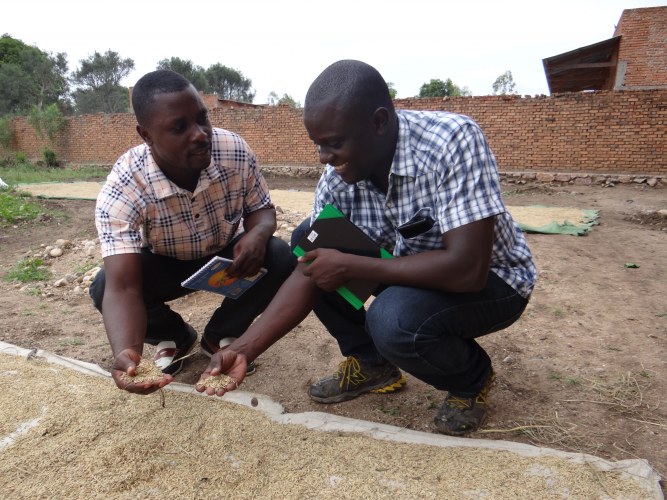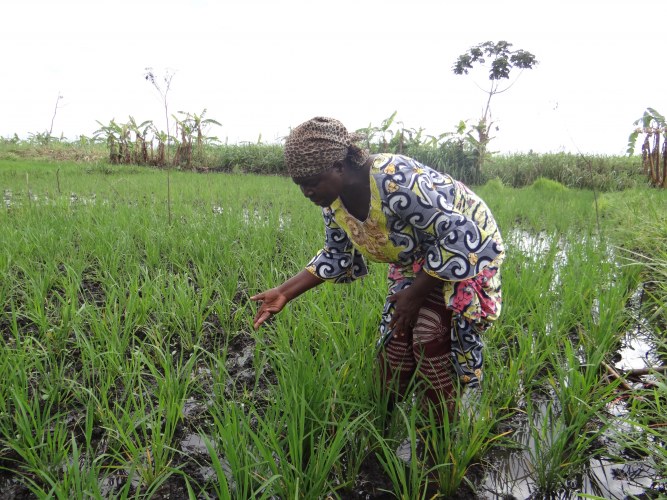Germaine Furaha Mirindi is a Ph.D. student in Economics and Rural Development at the University of Liège, Belgium. She is also teaching at the Université Evangélique en Afrique, in Bukavu. In 2015-2016, as part of a collaboration between VECO-RDCongo and Cordaid, she conducted a study on the rice sector in South Kivu, in the eastern part of the Democratic Republic of Congo. In this province, VECO RDCongo supports the rice growers in becoming more professional and producing a higher quality and quantity in order to conquer the market of Bukavu. We collaborated on this issue with Cordaid. Germaine Furaha Mirindi shares her conclusions in this interview.
Radioscopy of the irrigated rice sector in South Kivu
Radioscopy of the irrigated rice sector in South Kivu
Can you talk about the importance of rice in the diet of the average Congolese?
According to FAO data, rice consumption is stagnating in DRC, and is between 4.7 kg and 5.3 kg per person per year. Indeed, whereas until 1999 the annual consumption per inhabitant was 5.3 kg, it has decreased to 4.5 kg in 2005/2009, then slightly increased again to 4.74 kg between 2010 and 2015, and 7 kg in 2016.
However, these figures hide the disparity between the different provinces of DRC, as differences in rice consumption are noted by province and area (urban or rural). According to the national rice strategy, consumption is 9,4 kg in the former Oriental Province, 17,5 kg in Sankuru and the province of Maniema, and 19.5 kg in the Kinshasa City Province.
During our investigations in 2015 the consumption is as high as 38.6 kg in the city of Bukavu and the municipality of Uvira in South Kivu (urban areas only). Except for Maniema and Sankuru, where rice is the staple food, rice consumption is a phenomenon linked to urbanization. It is important to mention that the use of rice in beer preparation is estimated to be 16% of national production. The constantly rising tendency of population and the demand of brewing companies entice a continuous growth of the need for rice in the country, while there is already a deficit of it.
In Bukavu and Uvira, rice constitutes an important part of food expenses in the households. Indeed, households spend around 29% of their budget on cereals and roots (substitutes compared to rice).
In your opinion, can rice growers of the plain of the Ruzizi conquer the table rice market of Bukavu?
Yes, of course!
Although local rice is suffering strong competition from imports that flood the Bukavu rice market, the results of our research allow us to conclude that “local consumption is a false debate" because people consume and would love to consume more local rice. However, consumers have demands: they want food products that evolve towards higher quality and that are more practical and healthy. People love rice that is easy to use, clean and does not require much time to prepare. Faced with a range of choices (local rice and imported rice), consumers remain rational. They have preferences and constraints: they choose what they want as compared to what is available and don’t hesitate to turn to imported rice if local rice does not meet their demands. To conquer the table rice market of Bukavu, rice growers of the Ruzizi plain will simply have to propose rice that meets the demands of the consumers.
So these demands or conditions are fundamental…
Consumers base themselves on a set of criteria.
The first criterion is the presentation of the product. It is very important, as it plays hugely on the psychology of the consumer. When the product is presented with a label or a specific packaging, the consumer already knows the origin of the product, and thus has no more doubt. It is surprising to note on the Bukavu market that the rice produced on the plain of the Ruzizi is packed in user bags with messages that have nothing to do with rice. Also, to make local rice accessible, the ranges have to be diversified: presenting rice in bags of 1 kilo, 5 kilos, 10 kilos to conquer various market segments, instead of only bags of 25 or 50 kilos, which makes rice inaccessible to certain consumers. To this are added the impurities and broken grains that characterize rice.
Second criterion, price. It is known: imported rice is less expensive than local rice. However, it is interesting to note that the high-end rice, the one from Tanzania, has a higher price than local rice. If the affluent consumer buys Tanzanian rice, it can be deduced that given equal quality, this consumer is also ready to pay the local product at the same price as the rice from Tanzania. This gives rise to some room for manoeuvring for local rice growers in terms of extra costs, in order to significantly improve their production.
Third criterion, quality. The consumer looks for rice with a certain number of quality features. Certain qualities like purity, colour, and unbroken grains must be sought at transformation level (husking). Other qualities such as aroma, fresh taste, rice that swells after cooking, rice that is clean and easy to cook, that doesn’t stick after cooking: so many elements to consider when choosing the varieties.
Last criterion: availability in time. It is not possible to create customer loyalty for a product that is almost always absent on the market. Local rice is rare on the market, because of its seasonal nature, which is explained by weak production. Producing rice in intrinsic and extrinsic qualities and at a competitive price is one thing, guaranteeing its availability in time is something else!
This availability depends on four main factors that must be integrated in every consideration. First, increasing production through rational exploitation of untapped rice-producing potentials, as only 22,4% of the rice growing areas of the Ruzizi plain are currently exploited. Second, increasing productivity of local rice through access to high quality inputs and techniques. Third, the existence of storage infrastructure. And fourth, the implementation of an efficient financing system for post-harvest activities.
What is being done presently to take on the challenges?
Not much, especially at government level. We positively appreciate the efforts of VECO in transforming and commercializing rice. The transformation units are mostly very antiquated. These units provide a rice of very bad quality. However, the efforts of VECO must be highlighted as they allowed farmers to have two new semi-industrial huskers, which deliver a rice of very good quality. Other noteworthy efforts are made in the drying areas and storage warehouses. Thus, if there are other efforts that support what has been done already, farmers can take on the challenge. As for commercialization, contracts with big traders are needed to sell the rice to the Bukavu households. What has been done on the contract issue is supplying to BRALIMA (a brewing company in the region, editor’s note).
Can we say that the seeds that are currently used cannot meet the quality challenge of table rice?
Not at all. Seeds with the qualities required by the consumers are not very widely spread in the Ruzizi plain. That is also, in part, because the rice growers don’t produce considering what consumer households want. And yet, these last are the main part of the market. The rice growers are often limited only to the market of BRALIMA, which is only a small market. Rice growers mainly grow the IRON variety for BRALIMA, which is not preferred by households. It is well understood that the challenge is also at producer level. In time, there have been efforts made by certain development partners, certain NGOs have proposed intensification techniques for rice culture, allowing the use of high quality inputs (seeds, fertilizers and plant protection products), and modern techniques, but after the projects many producers have not perpetuated the achievements of the projects or adopted these new techniques.
A viable seed sector is needed. People must produce in function of the needs of consumers but also of the competition. If a well-organized, well-structured seed sector is implemented, we can meet the challenge.
Which can be the other efficient ways of reducing production expenses and thus improving competitiveness of local production?
The high production cost is explained by two different reasons. On the one hand, it can be caused by insufficient production, in other words, a weak yield. On the other hand, production costs can be elevated because production factors are expensive. Two measures can be applied to minimize production costs: in productivity and in production.
First, work has to be done for the yield. The same Ruzizi plain is shared with Ruanda and Burundi, and there are disparities. In Ruanda, the yield is twice that of the DRC, with the same expenses made. Increasing productivity on the Ruzizi plain on the Congolese side passes through using good seeds, high quality inputs, technical support in order to apply all techniques allowing to achieve a yield to scale. To increase productivity, it is necessary to have a good circuit for the supply of fertilizers and plant protection products, agricultural equipment, technical support. There is also a need for irrigation infrastructure planning and good water management so the rice fields can have easy access to irrigation water.
Second, the cost of land weighs hugely on the producers. The price of the parcel of rice is twice or three times higher than for other parcels. Also, access to plant protection products and other inputs like fertilizers are a problem, contrary to the case of the Imbo plain in Burundi, where inputs are accessible to farmers for an affordable price. Besides, it is to Burundi that many Congolese rice growers go for supplies in order to reduce costs. As I said, the supply circuit for inputs and seeds must be organized to change the situation.
And which may be the role of the Congolese government in changing the situation?
The government has a double role to play.
First, it must play its regulatory role better. Specifically in structuring sectors like the one of seeds and other plant protection inputs. The policy of subsidizing inputs is justifiable in a context like the one of DRC, in view of encouraging sufficient use of these inputs by producers. The State must support specialized players without necessarily intervening directly on the field. It must invest in agricultural research and in agricultural extension.
Second, once the rice sector has taken off, it is important to install protective measures like import taxes, in order to reduce the price differences between local and imported rice. Also, the State must promote local production by encouraging the population to consume local rice. And the State must set up a secure local rice market through its services: police, army, prisons… Surprisingly, State services eat much rice, though imported rice. The State must also encourage consumption of the “terroir” (local products) by raising awareness with local businesses like restaurants, hotels… In this sense, local production can be made known as we notice that a large portion of the Bukavu population does not know the rice of the Ruzizi plain. In my opinion, the ideas are realistic even in the current context of the country, where the State is failing in terms of agricultural financing. These proposals cannot weigh on the State budget, as they don’t cost much.
Are these proposals not part of the national rice strategy?
Not necessarily, as some are not included in it. There are certain elements that are cited in a jumble in the national rice strategy. Examples: agricultural research and extension, the seed sector, commercialization of fertilizers… The national rice strategy is evasive; it does not detail certain aspects. Indeed, that is its weakness. Its applicability and monitoring become rather complicated. The strategy must go towards more concrete and targeted approaches, as a document without precise details is of little use.
In your opinion, must this national rice strategy be reviewed?
Yes, that is necessary. The document must detail the programme targets and say how this will be realized. The strategy does not detail the priority areas. It mentions Congo in a general way. Concretely, which are the specific needs for every type of rice culture? Which are the priority lines for each type of rice culture and for each province? And what is more, there is no financial commitment at all by the government. The document is presented under the form of a financing request file, as anyone can write a project and seek financing. This is the big handicap. A strategy must present the situation, priority lines, restraints and opportunities, what must be done but especially accompany the document with a financial willingness from the government. As an example, the strategy has foreseen an increase in production going from 340,000 tonnes in 2012 to over 1,400,000 tonnes in 2018. Taking into account the weaknesses mentioned above, until 2015 the production has rather regressed and reached 307,306 tonnes. It is likely that this production does not reach half of the fixed objective. On the other hand, the governance model of the rice value chain foreseen by the strategy keeps a certain weight: it should be decentralized to facilitate implementation of measures and programmes. The government must say which are the means it wants to use and what is expected of its partners. It should also coordinate well the actions of all the partners, because if the partners continue working in a dispersed way, the goals will never be met.
When it is known that many important documents in DRC end up in drawers, it can also legitimately be feared that the national rice strategy, even if revised, remains dead letter. In your opinion, how can the situation be changed?
It all depends on the applicability of the document. The strategy can be revised or improved as I propose, and it will still be a good document for the drawer. What is needed are concrete actions. We have a document, we must add to it application measures. In order to reach the objectives set by the strategy, it is necessary that the government starts working seriously, that it collaborates and coordinates the actions of the other actors involved in rice culture and creates a good business climate able to attract national and foreign investors engaged in rice growing. There must be a regular evaluation to know what works, and what still remains to be done to improve.



